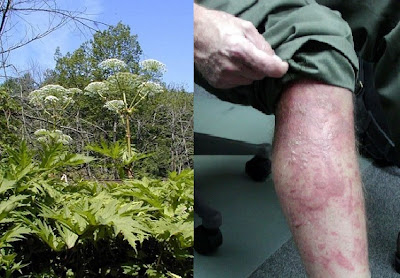The giant hogweed is a towering plant native to Central Asia that reaches up to 12 feet height with flowers as well as saps. The plant is highly hazardous as its sap can cause skin to react to sunlight that leads to blisters, long-lasting burns, dark blotches, permanent scarring and in some cases even blindness. This monster plant is now spreading at a remarkable rate across the state so the New York Department of Environmental Conservation (DEC) is worried about the invasion and asking for help situating outbreaks.
As the plant is spreading at an alarming rate, it has made a problem across many parts of the U.S. and abroad. The U.S. Department of Agriculture has classified it a “federal noxious weed.” As per the officials, the plant has been spotted at 944 sites, counting spots in Nassau County, Long Island and Putnam County. So, experts are entreating residents of numerous states to be cautious of the "giant hogweed."
The Department of Environmental Conservation has also set up a special Hogweed Hotline at 845-256-3111. New Yorkers can call at this number to report sightings of the invasive species and give photos of potential outbreaks so they can send crews to annihilate the toxic weed. However, the agency warns the picture takers not to touch the plants.
Giant Hogweed’s scientific name is Heracleum mantegazzianum and is indigenous to the Caucasus Mountains area, connecting the Black and the Caspian Seas. In 1917, the plant was first introduced as an ornamental garden plant to the United States. Garden expert Mike McGrath named the sap as “One of the most irritating, if not the most irritating plant substance on the planet.”
The plant is especially hazardous for children. When the stalks of the plant are busted, the sap is released. Playing children are especially attracted to the distinctive long limbs. Hearing of children has been reported by Kraus using the stems as telescopes that lead to severe burns around the eyes.
What to Do If You Come in Contact to Giant Hogweed?
- First of all, rinse the affected area thoroughly with cold water and soap as soon as possible.
- Avoid sunlight or keep exposed area away from sunlight for about 48 hours.
- If a reaction takes place, then apply topical steroids as early as possible because it can reduce the severity of the reaction.
- If your eyes come in contact to sap, then wash them with water and wear sunglasses.
- The area of skin may be perceptive to sunlight for a few years if a reaction has taken place. You may need to apply sun block or keep away the affected area or keep it covered from the sun when possible.
- Please contact to a physician if you have any reaction or any questions.
Giant Hogweed Identification and Comparison with Cow Parsnip video from Youtube:









0 comments:
Post a Comment